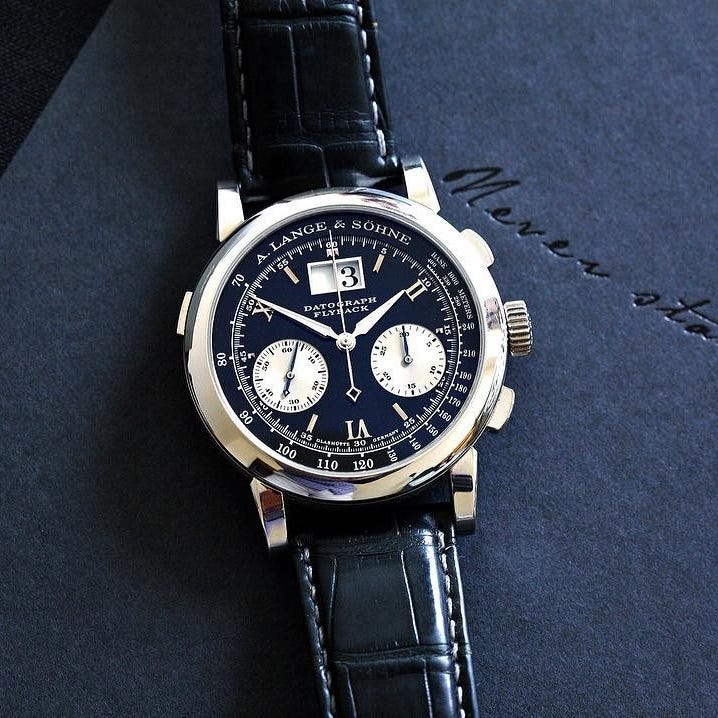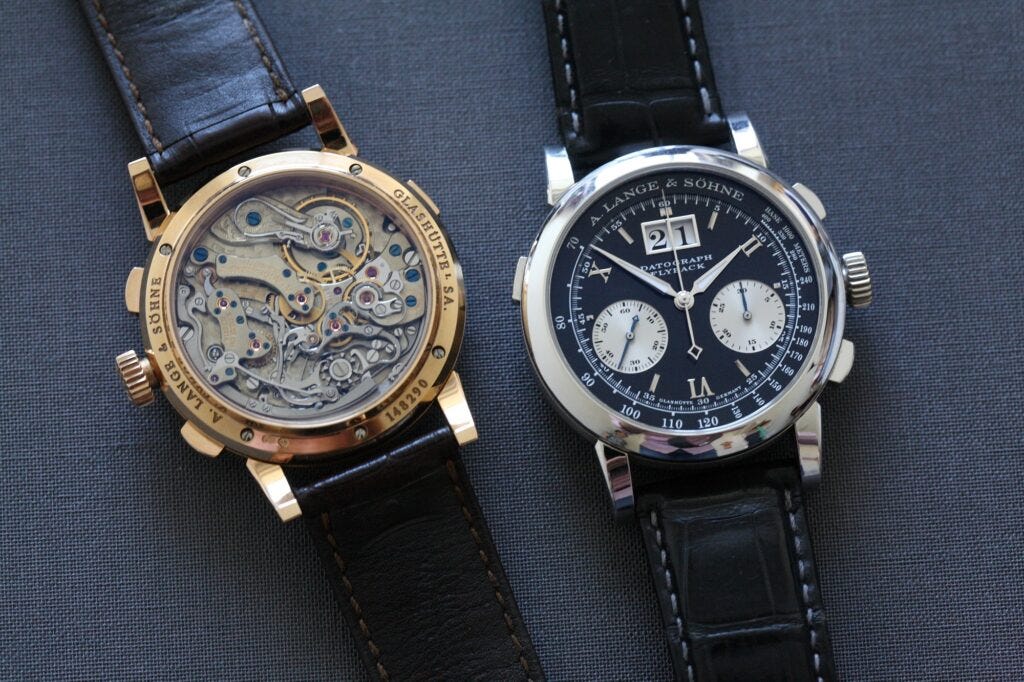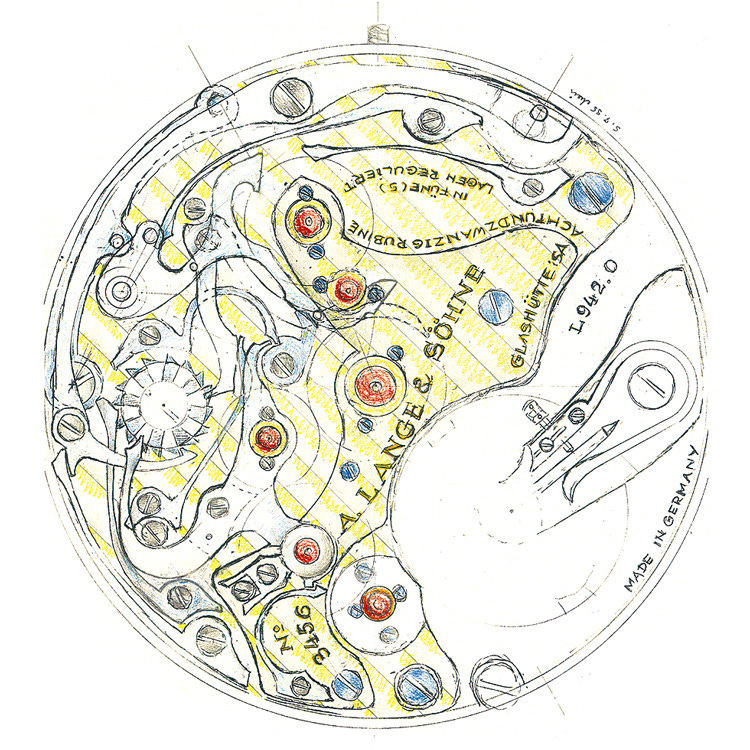The definitive guide to the A. Lange Datograph
Langepedia's in-depth article on Lange's most iconic model
Langepedia is the definitive encyclopedia on all things A. Lange & Söhne. Started by Alp, a young Lange enthusiast and collector, in the midst of the pandemic, it’s a source for in-depth, encyclopedic articles on the most important Lange references. It’s an extension of the Instagram @Langepedia which Alp started in 2016 when he was a freshman at university.
I’m a long-time follower of Alp and Langepedia, so I wanted to partner with him to bring you his reference guide on perhaps Lange’s most important and recognizable model, the Datograph. Enjoy. -Tony
👉 Rescapement is a weekly newsletter about watches, mostly vintage. Subscribe now to get it delivered to your inbox every Sunday:
All words and images courtesy of Langepedia
The watch industry has gone through several paradigm shifts over the centuries. It went from being utilitarian to functionally obsolete to luxurious, and as claimed today — art pieces and status symbols boasted with provenance and stories. Inevitably, the hardware part of the industry, the watchmaking, also followed. It transitioned from putting out fundamental inventions where one could see their value with observatory competitions and finally to gimmicky innovations to open up new markets and attract attention.
One of the latest shifts in the industry was without a doubt the in-house trend that took place within the last 20 years, where the traditional Swiss-style of outsourcing components was replaced by vertical integration. This, however, did not happen by itself. Among many triggers for such a move was a crucial one from a small town in Germany. This is its story: the Datograph.
The following article starts with asking the question why for the Datograph: why did A. Lange & Söhne make it? After understanding the conjuncture of the period, the article moves on to the in-depth analysis of Datograph models and their case, dial, and the movement of the first generation Datograph. Moreover, the article offers a detailed walk-through of the Datograph Up / Down and compares two generations. Finally, you’ll get my verdict on this icon.
The Background
A. Lange & Söhne came up with the Tourbillon Pour le Mérite in 1994, signalling that it wanted to fight for the highest echelon of complicated watchmaking. Yet, one-hit wonders alone do not place a new brand in this echelon — there are some quintessential complications a manufacture has to tap in order to gain a presence in the broader market, too. One of those complications is, without a doubt, the chronograph.
In the famous business book Positioning – The Battle for Your Mind Jack Trout and Al Ries talk about a concept called Product Ladder. Each step of the ladder is a brand name and each ladder represents a different category. So, if you are late to the market, you need to compete with an already established ladder in the consumer’s mind.
Now, apply the product ladder theory to the watch industry and consumers’ state of mind during the 1990s. Who do you have in mind when one speaks about a chronograph? Patek Philippe, Vacheron Constantin, Audemars Piguet, etc. — the usual suspects. Hence, for A. Lange & Söhne to succeed in such competition, from a product point of view, there was only one way up: create your own ladder or disappear.
In 1999, after decades passing by without a new chronograph movement, a company that was merely 9 years old came up with the most unexpected: an in-house chronograph: caliber L951.1 of the Datograph Flyback. An in-house chronograph of such magnitude, architecture, and finish was the new ladder. To make it more concrete, in 1998, Patek Philippe had just introduced the 5070 with a Lemania ebauche (which is also too small for the case). I love how the living legend Mr. William Massena summarizes this:
“It is always amusing to remember that the most beautiful chronograph movement of the 20th century was made by Germans. They gave 98 years to the Swiss to try their best.“
This is the watch that got me into watchmaking (no, it was not my grandfather) more than a decade ago, and since then, it still delivers the same excitement every time.
Datograph – 1999

Franken words are one of the most well-known linguistic practices in German, words that are formed by the combination of a couple of words. As a German company, Lange followed the language and created the name Datograph: date + chronograph.
Lange introduced the Datograph in platinum reference 403.035 at Basel Fair in a small, shared booth with siblings IWC and JLC in 1999. There was not a giant watch in the booth, as it is the tradition now; but a giant movement model, just to increase the rushing heartbeat of the Swiss competitors and to give them the opportunity to closely examine what they would have to deal with. Michael Hickcox, a well-known collector and a dear friend said, “the A. Lange & Söhne Datograph changed the future of watchmaking right there and then.”
The first generation Datograph was produced between 1999 and 2011. Before diving deep into the watch itself, I’d like to talk about the rarity of certain references. The break down of the versions is as follows:
403.035 – Platinum case, black dial – From 1999 to 2011
403.031 – Pink gold case, black dial – From 2003 to 2005 (“Dufourgraph”)
403.032 – Pink gold case, argenté dial – From 2005 to 2011
403.041 – Yellow gold case, black dial – In 2008 limitation not given but I assume something around 50 – 60 pieces (“Yellow Jacket”)
403.025X – Platinum case, silver dial – In 2004 limited to 10 pieces (“Albino Datograph”)
Of course, both due to being the first one and the most common version, the platinum Datograph with black dial is the most well-known and the face of the collection. Though please note that even if the reference was produced for 12 years, when you take Lange’s production numbers (5k pieces at most in those years) into account, it is very rare compared to most other brand’s flagship products.
On the other hand, the rightfully famous Dufourgraph reference 403.031 was produced only for about 2 years between 2003 and 2005. The reference takes its moniker from Mr. Philippe Dufour, who repeatedly stated that the Datograph is the best chronograph ever made, and that he owns one in pink gold.
Among the usual three, the reference 403.032, pink gold / argenté dial is the underrated one. If the Datograph collection were Metallica, this would be the Jason Newsted of the group. No less talented, yet overshadowed by its predecessor. Indeed, the original platinum / black dial Datograph plays a huge part in the 403.032‘s unpopularity, because people think that the black dial version is the one to have for collectability purposes. It is true to some extent; however, the 403.032 is no less beautiful. In fact, in comparison, it is much more sober and present; hence it certainly lures its own crowd.
The Verdict
The Datograph is one of the most important watches in modern watchmaking history. For Lange, it is undoubtedly one of the faces of the brand, one of the watches that put them on the map and perhaps at the top of its ladder.
There is one question people have been asking for almost a decade: Original Datograph or Up/Down? Although it comes down to each one’s taste, a connoisseur and a dear friend, Paul (@alangejourney) perfectly answers the question:
“This is similar to the evolution of the Datograph Perpetual. For someone deciding, the second generation is more of an introduction to the brand as it is now, and that might be better for someone starting out with Lange. But there is nothing comparable to having an example of ‘the piece that started it all,’ and that tilts to the first generation.“
For Langepedia’s full 5,000-word exploration of the Datograph, head to Langepedia.com. There, you’ll also find full in-depth articles on other iconic Lange models like the 1815 Chronograph, Lange 1, and more.
Rescapement is a weekly newsletter about watches, mostly vintage. Subscribe now to get it delivered to your inbox every Sunday. Follow us on IG too.







